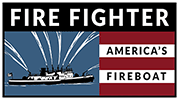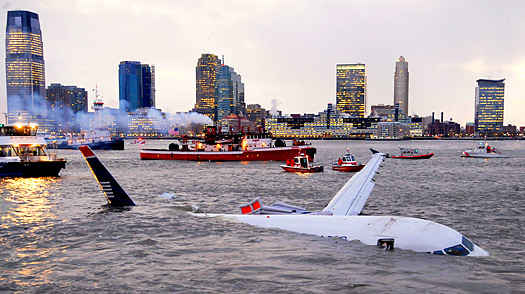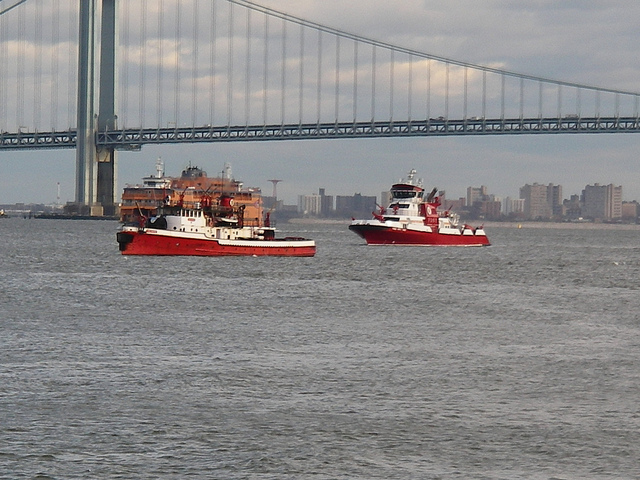
Fire Fighter at her Staten Island berth as Marine 9/Engine 51, located at Slip 6 at the Staten Island Ferry Terminal.
Arriving to her new berth in Staten Island amid one of the greatest periods of change in American commercial shipping in its history, the Fire Fighter, now the second oldest boat in a FDNY fleet which had been largely renewed in the late 1950’s and early 1960’s, was nevertheless once again right in the thick of marine trade moving through New York Harbor. Unlike her previous assignments however, she was no longer sited amongst the piers, terminals and warehouses of the working waterfront; she was now keeping watch over the strategically vital entrance to New York Harbor, which was being transited by increasingly large and more numerous numbers of Containerships and Oil Tankers calling the Port of New York and New Jersey and the Chemical Coast beyond.
Shortly after midnight on June 2, 1973 two of these such vessels, the Belgian-flagged oil tanker SS Esso Brussels and the US-flagged containership SS Sea Witch collided almost directly beneath the Verrazano Bridge, where the tanker was anchored while awaiting a berth after Sea Witch lost control of her steering. Bathed in the light from the enormous fireball that resulted from the impact and the enormous fire that soon enveloped the two ships, Fire Fighter’s ready crew immediately responded to the nearby inferno, which at the time was sending flames high enough into the sky to scorch the steel on the Verrazano Bridge.
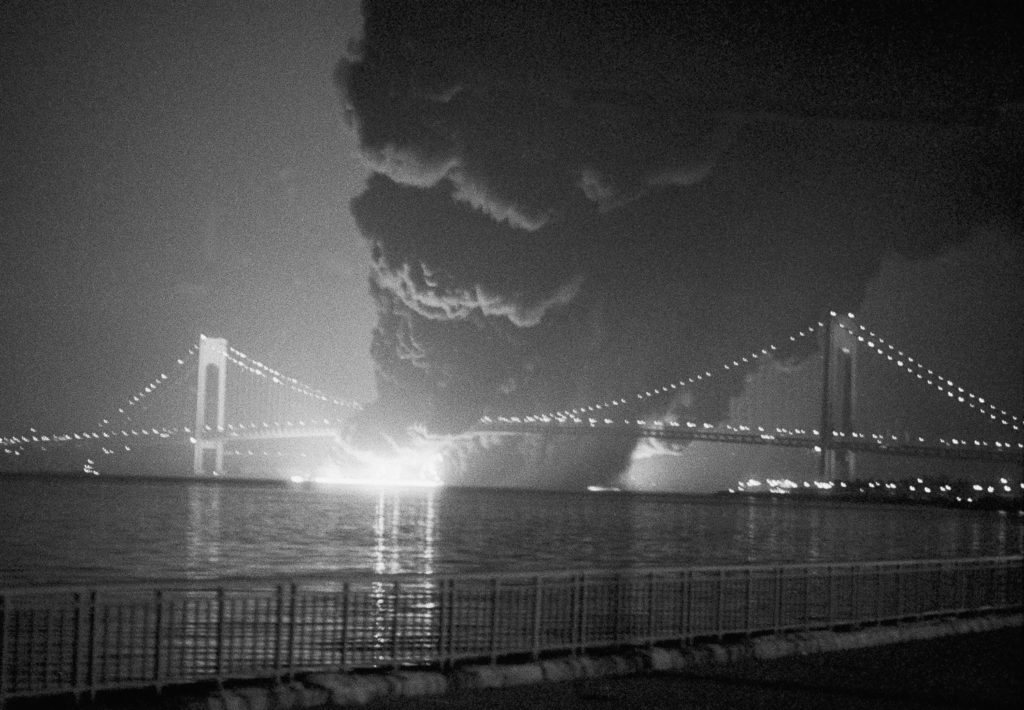
Fire and smoke from the collision of the C/V Sea Witch and SS Esso Brussels envelops the Verrazano-Narrows Bridge on the night of June 2, 1973, in this photo taken from the shore of Gravesend Bay.
Battling the huge flames by herself with every monitor aboard ship, Fire Fighter’s crew chased the two ships into New York Bay as they drifted on the outbound tide, all the time thinking the Esso Brussels was the sole vessel involved in the event. Only when the two vessels grounded in Gravesend Bay did the hull of the Sea Witch appear through the flames, and with it the blinking flashlight of a Sandy Hook Pilot as he desperately signaled the Fighter’s pilot for assistance. Wasting no time, Fire Fighter’s bow monitor cut a path though the burning-oil covered water to the Sea Witch and her crew quickly sent up ladders that allowed the 30 surviving crew and harbor pilot to be safely removed from the vessel. For her and her crew’s efforts, Fire Fighter was awarded the Department of Commerce Gallant Ship Award, the highest honor that can be accorded a merchant vessel, while her crew received the 1974 American Merchant Marine Seamanship Trophy for their extraordinary seamanship and heroism during the rescue. To date, she is the only fireboat to have received either of these awards.

Lt. James McKenna accepts the Gallant Ship Award from Rep. Fred Richmond (D-Brooklyn) on behalf of Fire Fighter in a ceremony on May 2nd, 1975. Pic courtesy of the NY Post, hosted on Getty Images
Now a bona fide celebrity and living legend among both the New York Fire Department and Maritime Community, Fire Fighter continued to dutifully serve the mariners and citizens of New York, and was given the considerable honor of opening the 1976 Bicentennial Tall Ship Parade while stationed off Liberty Island and conducting water displays to mark the festive occasion. Not left without her share of fires during this period, Fire Fighter found herself increasingly called upon to provide support to landside units working major fires instead of fighting major shipboard infernos; a dividend of more stringent safety regulations and improved technologies aboard ships and at the terminals they called. Nevertheless, major fires like the November 1987 conflagration at the Gordon Tank Farm and several vessel collisions and fires in the harbor kept Fighter and her crew occupied through the 1980s.
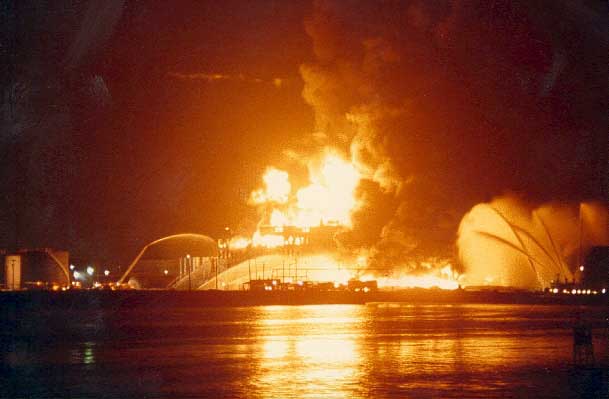
Fire Fighter (at the extreme right) puts up a curtain of water to keep flames from spreading from the Gordon Tank Farm to adjacent oil tanks.
Celebrating her 50th year on duty with applications for listing on both the National Register of Historic Places and as a National Landmark, Fire Fighter duly received both on June 30, 1989, a well earned recognition for a vessel which had contributed so much to New York Harbor over her career. By 1990 Fire Fighter was one of only four large FDNY fireboats in frontline service and was still the ranking powerhouse of the fleet, and though she was getting on in years the Fire Department seemed to have no inclination of replacing her since she was still more than capable of executing any task assigned to her in her almost-unaltered 1938 state. Shifting her berth for the final time in her active-duty career in the early 1990’s Fire Fighter departed her longtime home at Slip 6 in the Staten Island Ferry Terminal for a dedicated post at the newly-built US Navy “Homeport” at Stapleton, Staten Island, where she would serve out her years in FDNY service. Becoming the “Queen of the Fleet” in 1999 following the decommissioning of her longtime fleetmate John J. Harvey, Fire Fighter entered the new millennium and began her 61st year of frontline service.
September 11th, 2001
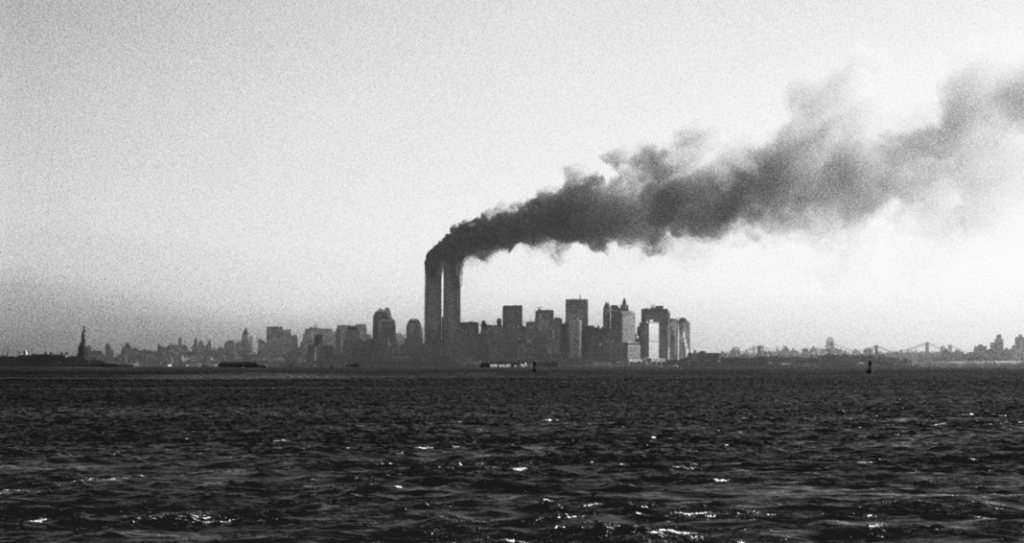
The view from Staten Island on the morning of September 11th, 2001. Pic courtesy of http://www.vindustries.com/
Like so many of us, the morning of September 11th, 2001 was just like any other for Fire Fighter and her crew, who went about their routine tasks through the early morning hours on what was a warm, cloudless day with a typical September deep blue sky. The impact of American Airlines Flight 11 with the North Tower of the World Trade Center at 0846hrs disposed of any notion of a routine day, and within minutes of the 2nd Alarm being rung out Fire Fighter had slipped her mooring lines and was on her way across New York Harbor on what would be the longest, darkest and most important call of her storied career. Intending on joining the FDNY Marine Unit response to assist with what seemed to be a terrible aircraft accident, Fighter and her crew were still crossing the harbor when United Airlnes Flight 175 streaked overhead and slammed into the South Tower at 0903hrs, changing everything. Responding to the foot of Albany Street and linking up with the fireboats John D. McKean, Kevin C. Kane, Smoke II and a re-activated John J. Harvey, Fire Fighter and her crew spent the three weeks engaged in a marathon pumping operation to supply water for firefighting and recovery efforts at Ground Zero. For her crew, the 9/11 response was a seemingly endless effort to run hose line from the waterfront to abandoned, damaged and burned out but operational engines in the rubble to maintain water pressure over the tremendous distance.
As the most capable pumping platform operated by the FDNY, Fire Fighter spent nearly her the entire time of her 9/11 response pumping at maximum capacity, and by the time enough landside water mains and hydrants had been repaired the Fighter had literally run herself ragged; her Port side engine had burned through its cylinder rings and was barley functional and all four of her fire pumps were on the verge of breakdown. Having given her all for those who gave so much more in the line of duty on 9/11, Fire Fighter returned to her berth in Staten Island and stood down for inspection and repairs.
Final Years
With her capabilities in demand more than perhaps ever before in a post 9/11 world, the FDNY ordered Fire Fighter to Caddel’s shipyard in early 2003 for a much-needed overhaul and full hull and machinery inspection. Despite her advancing age, she proved her mettle and the soundness of her construction and was found to be fit for several more years of service. However, the realities brought into the light by the attacks of 9/11 illustrated that New York City’s first responder apparatus needed to have modern counter-terrorism capabilities, particularly the capability to operate in areas exposed to chemical, biological and nuclear contaminants. While certainly a design requirement that Francis Gibbs could not have foresaw when he first put pen to paper on the Fighter in 1937, it was a bridge too far for the 63 year old vessel, and shortly after she re-entered service from her yard period the FDNY began the daunting and nearly decade-long task of designing and building a suitable replacement for the Fire Fighter.
Despite her frontline service days clearly being numbered, Fire Fighter still maintained her watch over the Verrazano Narrows and kept up a busy schedule of calls in her last decade on duty. Fighting her last major vessel fire on February 21, 2003 following the explosion of a fully-loaded gasoline barge at Port Mobil in Staten Island, New York. Fire Fighter also played a major roles in the emergency response to the October 2003 Staten Island Ferry Disaster. Working her final major fire on May 2, 2006, Fire Fighter was called upon with the majority of the FDNY Marine Unit to fight a large fire at an abandoned Brooklyn warehouse complex which eventually reached 10 alarms before it was brought under control after several days.

Fire Fighter working her last major fire, with her bow montior in action and deluging the 10-alarm Greenpoint Terminal Market fire on May 2, 2006. Pic courtesy of www.stevespak.com
The Fighter’s last major call to action came in January 2009 when she responded from Staten Island to the Hudson River to assist with the rescue and recovery of passengers from US Airways Flight 1549, which had ditched in the Hudson River following a birdstrike. Primarily assisting her fleetmate John D. McKean, Fire Fighter operated as the onscene FDNY command unit throughout the response as the airliner was nudged towards the Battery and secured for salvage.
Attending her final “Blessing of the Fleet” ceremony on July 17, 2010 along with her fellow fireboats John D. McKean, Governor Alfred E. Smith, and the newly-delivered 343, Fire Fighter’s FDNY career came to an end with the arrival of her replacement, appropriately named Fire Fighter II in November 2010.
After standing her post for another month while the “new boat” was put through her paces, Fire Fighter went out of service for the first time in 72 years on December 7, 2010 with the commissioning of Fire Fighter II and reported to the Marine Division docks at the Brooklyn Navy Yard for layup, where she would remain the FDNY’s first-due reserve fireboat for the next two years.
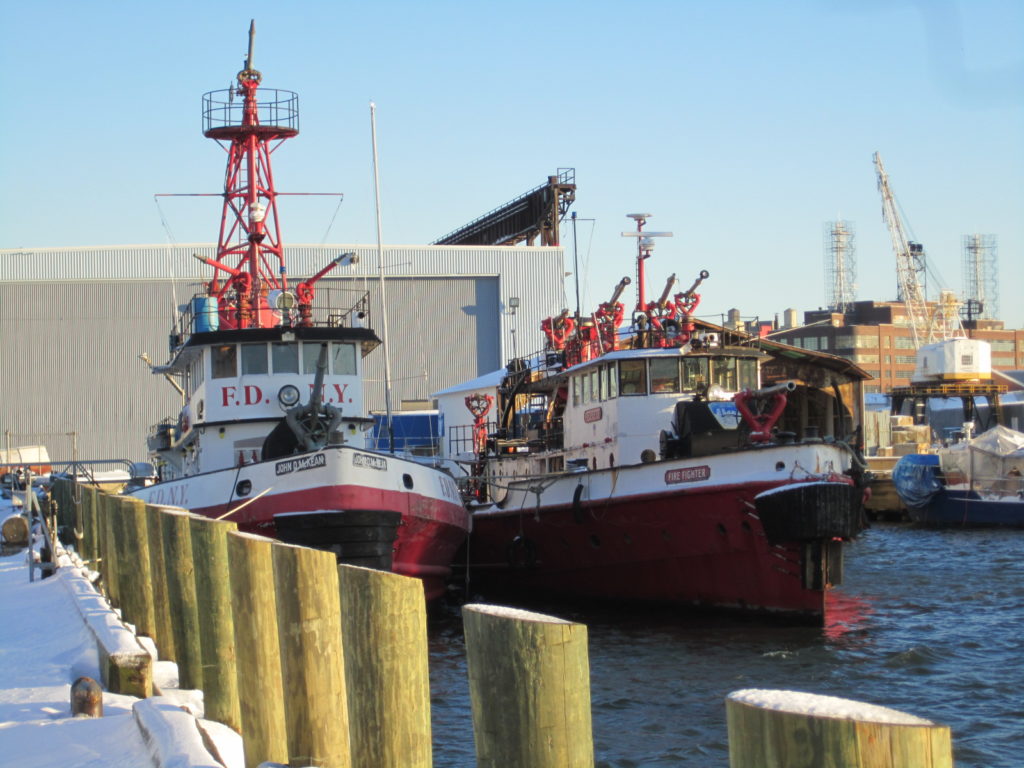
Fire Fighter and John D. McKean share a berth in retirement at the FDNY Marine Division Headquarters at the Brooklyn Navy Yard.
